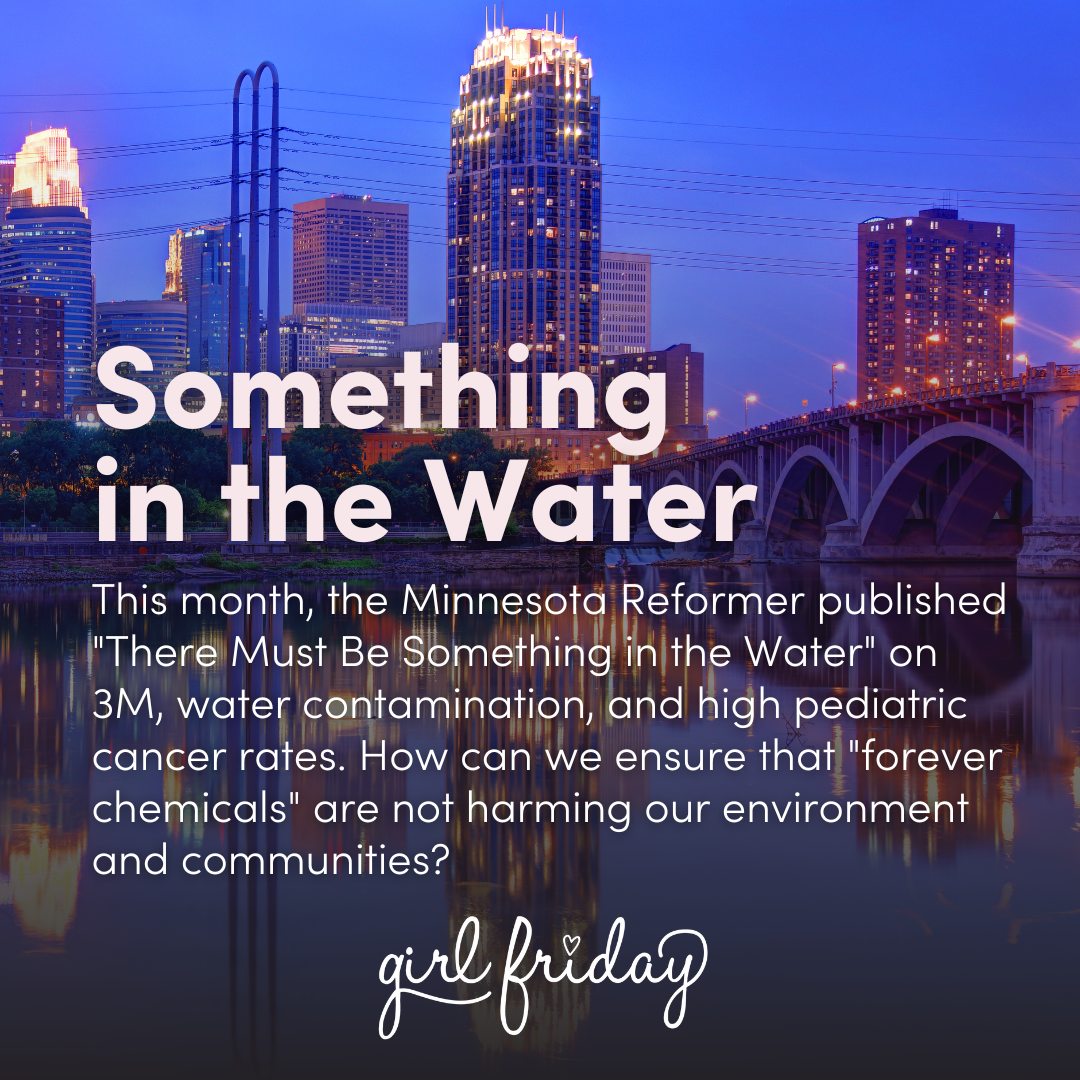Something in the Water
This month, the Minnesota Reformer published "There Must Be Something in the Water," a two-part series on 3M (a company that operates in the fields of science, technology, and public health). The series covered chemical contamination in the waters of Minnesota that may have led to high cancer rates in communities like Oakdale, MN. While it is difficult to positively link each specific diagnosis to 3M's chemical waste, the connections are impossible to ignore. The Minnesota Reformer series focused on the pediatric impacts of the environmental catastrophe. They learned that at Oakdale's Tartan High School, students often said, “Don’t drink the 3M cancer water.” Current and former young Oakdale residents like Amara Strande, age 20, are battling rare cancers, suffering through multiple surgeries and facing life-altering diagnoses. There are numerous ways for "forever chemicals" (a common term for the per- and polyfluoroalkyl substances referenced in this case) to seep into our environment, drinking water, and bodies. What can we do to protect our communities and our planet?
This 3M tragedy dates back to the 1940s.
Throughout the 1940s and 1950s, 3M's private contractors disposed of the company's waste on land that is now the town of Oakdale. In 1981, the Minnesota Pollution Control Agency (MPCA) learned that waste had been buried in Oakdale. However, it took more than 20 years for the Minnesota Department of Health to have the necessary tools to analyze chemicals in the water. In 2005, state officials announced that chemicals had been discovered in five Oakdale wells, acknowledging that the drinking water was, in fact, possibly contaminated. The mayor at the time told residents that the level of chemicals uncovered was low and that the water was safe to drink. The mayor even took a sip of tap water to underscore the point. Given these conflicting scenarios, the question was raised if Oakdale's water was truly safe. The Minnesota Reformer found a 2017 study that revealed an answer: "[...] a child who died there between 2003 and 2015 was 171% more likely to have had cancer than a child who died in the surrounding area."
The company knew it was polluting groundwater.
In the 1950s, 3M started manufacturing per-and polyfluoroalkyl substances in Cottage Grove, Minnesota, roughly 20 minutes by car from Oakdale, to create heat and stain-resistant coatings for products like Scotchguard and Teflon cookware. These production processes generated thousands of gallons of chemical waste annually, paling in comparison to the millions of gallons of waste they rendered each year starting a decade later in the 1960s. In 2010, as part of a lawsuit, the state's attorney general uncovered 3M's internal documents. Those records revealed that the company knew as early as the 1960s that they were polluting groundwater. In response, 3M said that dumping wet waste into landfills during that era “was a common and accepted practice at the time." In 2018, the state of Minnesota won an $850 million dollar settlement in that lawsuit against 3M.
When "forever" is fatal: the federal response.
In September 2022, the Environmental Protection Agency (EPA) proposed to designate "forever chemicals," including polyfluoroalkyl substances (PFAS), perfluorooctanoic acid (PFOA), and perfluorooctanesulfonic acid (PFOS), as hazardous substances under the Comprehensive Environmental Response, Compensation, and Liability Act (CERCLA), which is more commonly referred to as Superfund. The Superfund was established by Congress in 1980, and among other things, it created a trust to fund toxic waste cleanups. EPA's new proposal "would increase transparency around releases of these harmful chemicals and help to hold polluters accountable for cleaning up their contamination."
Encourage your state legislature to regulate the use of "forever chemicals" in industries and spaces that are the most harmful to people and the planet. While there is movement at the federal level, in the U.S., sometimes more immediate action occurs at the state level. This fall, California's Governor Gavin Newsom signed two bills banning PFAS in textiles, cosmetics, and personal care items in his state. As one of the largest economies in the world, California's legislative measure signals that this is a viable blueprint for global public health and environmental protection. The law will go into effect in 2025, giving corporations time to amend their production of potentially harmful toxins. Arlene Blum, the executive director of the Green Science Policy Institute, told NBC that "once PFAS escape into our air, water, and soil, they stay forever and harm our children and all of us. These two bills will make products, people, and our planet healthier." Using California as a model, you can encourage politicians to create a similar path for your state or country. Looking for your U.S. state legislatures? You can use the Open States "Find Your Legislators" tool.

